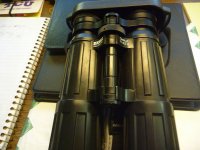For those who are interested in the discovery and the cure of phase problems in roof prisms and how to cure them, read:
G. Joos, Zeiss nachrichten 4, heft 9, page 221-227, 1943 entitled; "Die Bildverschlechterung durch Dachprismen und ihre Behebung". It describes how the phase problem occurs and how to cure it.
In a paper already mentioned on this forum is described how phase-correctd roof prisms can be made and how the presence of the coating can be tested read: Adolf Weyrauch and Dr. Bernd Dörband, Deutsche Optikerzeitung nr. 4, 1988, "P-Coating: optimized image quality for binoculars using phase-correctd coatings". In that same year Zeiss introduced the first roof prism binoculars with P-coating.







